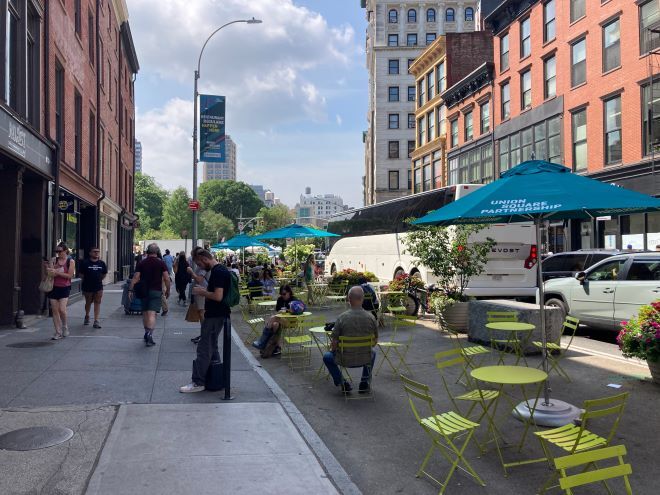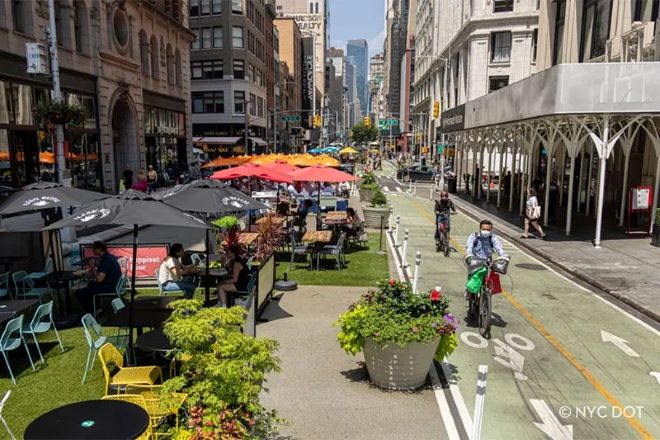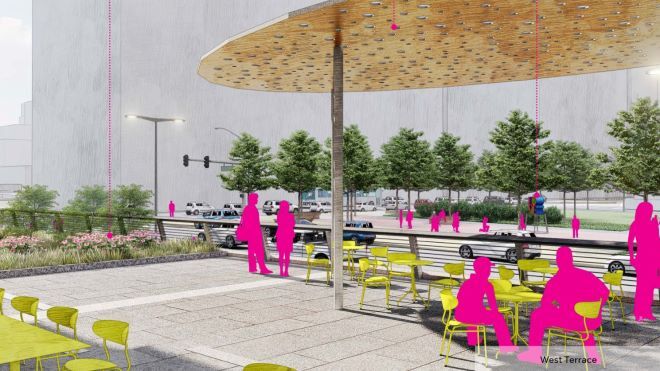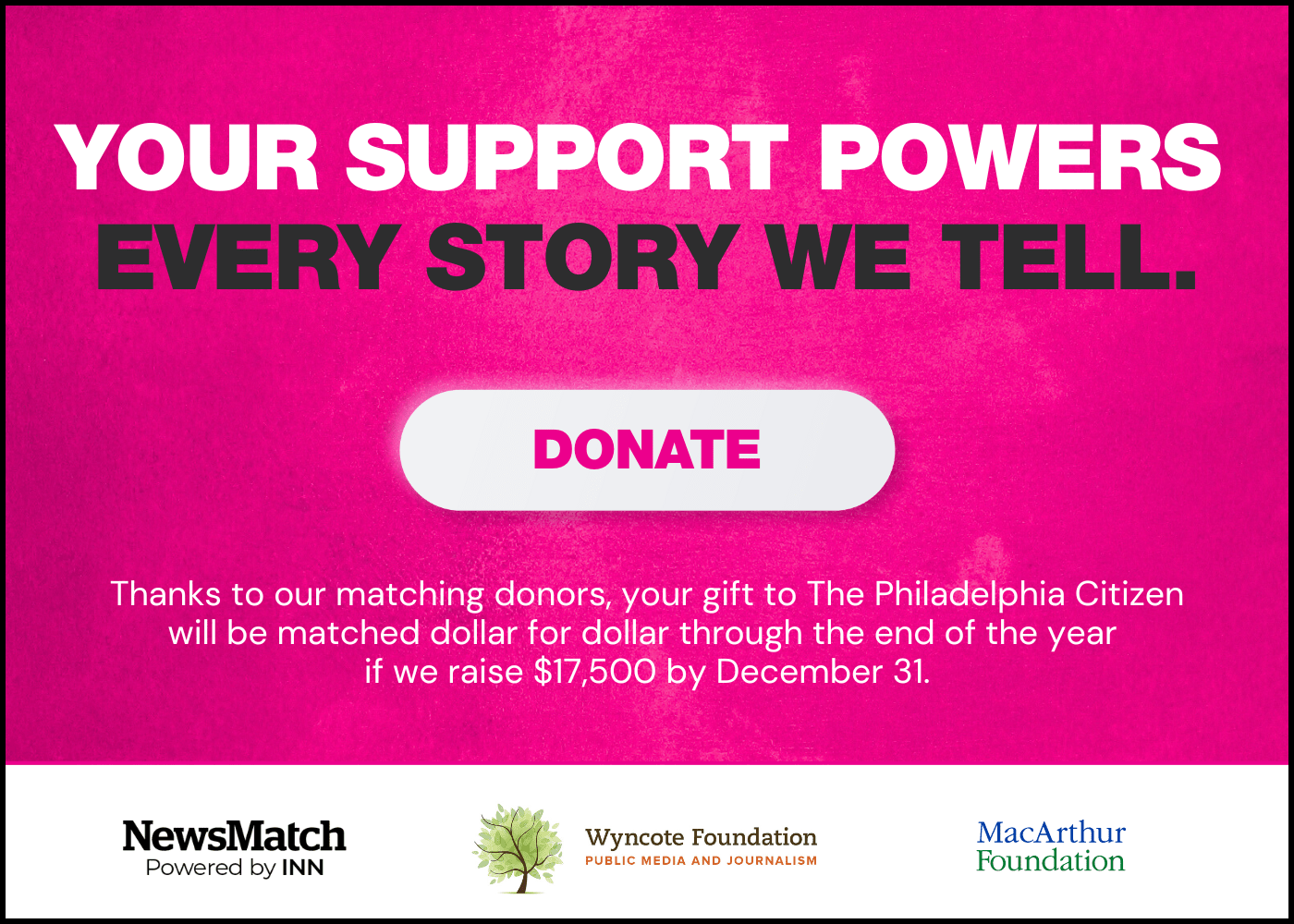I was recently in New York, walking from Penn Station to Union Square along Broadway. This stretch of Broadway has undergone a major transformation over the past decade: Once a traditional swath of bustling Broadway, it’s now a kind of woonerf with bike lanes, sidewalk cafes, and a little space for cars to pass through slowly.
This is a much more healthy, vibrant use of space than just cars, and converting roadway to pedestrian uses is a difficult and brave thing for the city to do. But I couldn’t help feel the same creeping disappointment that I feel in a lot of newly created public plazas where there isn’t the money, the permanence, or the mindset to create great landscape design.

We rely heavily on moveable chairs and the people in them to do the work of enlivening public space. Sometimes the public space succeeds — for example, in Bryant Park, which perhaps deserves credit for popularizing the moveable metal chair in American parks and plazas — but increasingly, when I see moveable, metal chairs in a public space I feel like it’s a cop out.
Bryant Park offers a lot for the senses: architectural vistas, grass you can lace your fingers through, the crushed gravel underfoot, established trees on the perimeter. The chairs simply try to not detract from the park’s assets.
By contrast, up and down Broadway — and in countless public parks across the country now — moveable chairs are the design. They add all the color, they’re the sole amenity; they offer sitting as the primary activity. And as a result their lightweight, flexible nature can in many settings start to feel aimless, almost offensively inoffensive.
We have many parks in Philadelphia littered with moveable chairs, so I was not surprised when the City announced a new design for the plaza surrounding the Municipal Services Building and found bright moveable chairs in the renderings. The bland design is relying on these powder-coated seats to suggest the space is hip, flexible, casual.
But my cynicism grew angrier when I realized the proposed public space’s design makes no overture to the adjacent bus stop at 15th and JFK — where no less than 11 bus lines pick up passengers. I couldn’t find anything about the fact that the plaza also sits above Hub of Hope, a homelessness support center, either.
Like so many public spaces these days, there’s no connection between form and function here. Ironically, it’s placemaking that starts to feel placeless. The strip of Broadway mentioned above has been turned into an outdoor food hall, extensions of cafes that displaced the flower and fashion industries that thrived in the neighborhood throughout the 20th century until gentrification pushed them out. Wouldn’t it have been more interesting and meaningful to return some space to small flower and fashion vendors?

“Lighter, quicker, cheaper”
Cities have done a good job with the “lighter, quicker, cheaper” ethos of placemaking — and our thanks are due to many organizations that have pushed cities to realize that we can quickly and effectively improve upon paved parking lots and plazas with not much more than some cans of paint and moveable metal chairs.
Indeed, it’s because of this movement of placemakers that we have developed a culture of caring about public space in many American cities, and New York has appointed a Chief Public Realm Officer. But we have so focused on the low cost of modestly improving spaces that we have failed to think about the opportunity cost of not more fully developing them.
Temporary public design has its place in the array of design solutions. We need pilots to prove what is possible, often with little money. But there’s often a long lag time between temporary and permanent — Times Square was first pedestrianized in 2009 and didn’t get Snohetta-designed permanent stone benches until 2017.
And the culture of temporary has seeped its way into many public designs, in a way blinding us to the possibility of the permanent. So many public spaces count on food trucks for commerce that they’ve forgotten about the value of purpose-built cafes or shops, again showing how design is an afterthought.
The popularity of moveable chairs has created a design rut. And that inertia is too risky for cities at a time when they must prove with every square-inch of real estate their social, economic, and environmental viability.
So what if we “banned” moveable chairs from new public space designs? Could this be a productive constraint that would push cities and designers to reimagine how they engage the public in parks and plazas?
Such a constraint might force us to solve problems other than just the most basic question of where people will sit. For example, if we ask how public space is going to reduce urban heat island effect or mitigate flooding, maybe trees or porous paving would drive the design decisions. Or how might this public space attract and engage kids and teenagers or connect socially isolated seniors?
For the Municipal Services Building Plaza project and so many others, I would want to ask how the public space is going to make city living easier: How is it going to make accessing city services enclosed in the Municipal Services Building easier? How will it serve those hundreds of bus riders who wait at the edge of the plaza and make their trip home easier?

Some ideas for a better way
There are, of course, public spaces that are moving past the hegemony of the moveable chair. Consider Boston’s City Hall Plaza’s recent renovation, where playspaces are prioritized, turning the humdrum activity of visiting City Hall or even being in the vicinity into a fun activity. This public space stands for something — play, activity, young people — and it suggests that City Hall prioritizes the next generation.
Yes, moving beyond moveable chairs will require investment — but some have great ROI. Think of the St. Petersburg Pier, a 26-acre city-owned property, that features playgrounds, beaches, public art, a marketplace, and half-dozen restaurants. It cost a lot to build but it’s the centerpiece of downtown St. Petersburg’s tourist economy, generating jobs and revenue. And how many public spaces could you spend an entire day in? This one offers that possibility.
Think of Nantes, Frances, where a public space was converted temporarily into a roller skating rink. The roller rink structure itself is striking and beautiful, and it allows for activity inside and contemplation and rest on the rink’s outside edges. It returns the sense of a central meeting space and focus to this public plaza, but does so in a way that refreshes how people meet in this space.
In Nantes, the mayor has a vision of becoming the world’s first nonsexist city and is focused on improving the public realm as a result. The city is redesigning one-third of its schoolyards and parks to incorporate children’s feedback in the design, and is working to transition 1,000 households each year from car-centered travel to public transit.
The city is also converting a huge surface parking lot into a massive garden. Though the project design does call for a few moveable chairs, it has design elements that will make this a stunning park when complete. I love this moment in a video about the project, where we see two women and a baby sitting on a blanket in wild grasses.
And this other image of an ostensibly independent young girl biting an apple sitting on a beautifully designed site-specific bench.
What a fresh vision of how to occupy public space and a far cry from the tyranny of moveable chairs! What a beautiful way to lower the urban heat in Nantes and introduce 1,000 new trees and other natural elements into the city. What a wonderful reclamation of public space from private parking. And what a ways we must go in so many of our cities.
Diana Lind is a writer and urban policy specialist. This article was also published as part of her Substack newsletter, The New Urban Order. Sign up for the newsletter here.
![]() MORE ON REMAKING URBAN LANDSCAPES FROM THE CITIZEN
MORE ON REMAKING URBAN LANDSCAPES FROM THE CITIZEN






